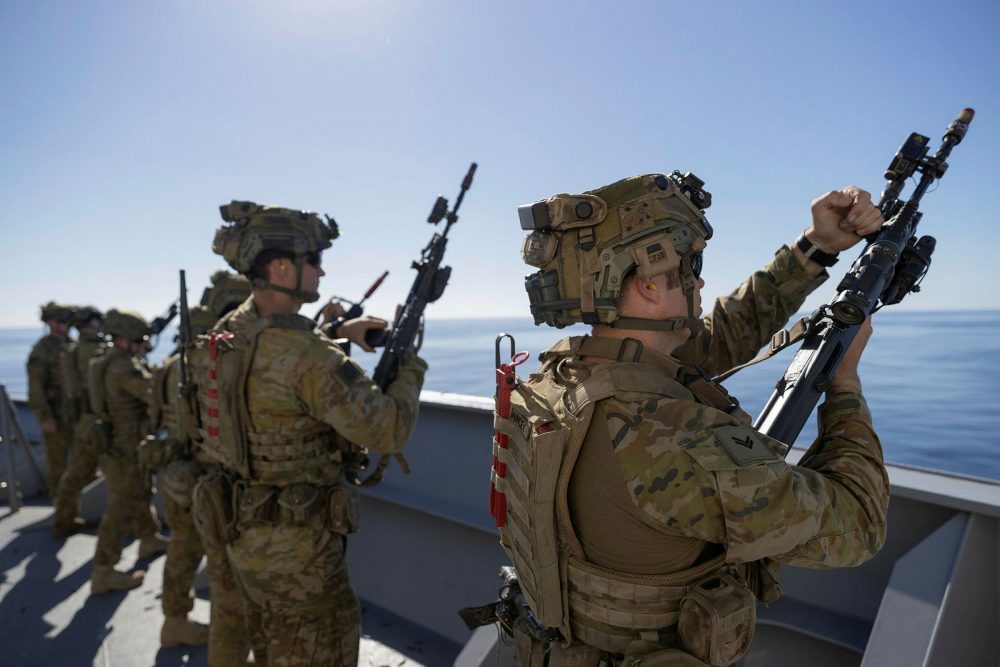
In 2019, Exercise Talisman Sabre ended with an airdrop of 26 tonnes of humanitarian assistance into Shoalwater Bay Training Area. In 2021, the same location was used to open the biennial exercise with a multi-domain
firepower demonstration, highlighting the Australian Defence Force’s ability to transition from humanitarian assistance and disaster relief to warfighting. Helping uphold the rules-based international order and protecting Australia from all threats will require the ADF to rapidly switch between such operations.
Recent commentary has focused on organisational characteristics such as
capabilities, structures and
strategy. However, success will also lie in a more human dimension of war—agility. The ADF needs to be able to transfer core functions between operations and operating environments; apply consistent operational nodes, knowledge and domain expertise; and integrate with other nations for operational cohesion. That’s how it embeds the thinking and behaviour needed for problem-solving and overcoming known organisational limitations and vulnerabilities.
In
Planning to not lose: the Australian Army’s new philosophy of war, Albert Palazzo advocates a move away from
effect-based operations towards function-based activities and operations that will enable ADF personnel to transfer actions, competencies and behaviours between operating environments to achieve the goals in the government’s
strategic guidance. He outlines eight operational functions that the army will need ‘if it hopes to not lose a future war’. Six of the eight functions are contingent upon government direction and are therefore discretionary; they include maintaining a forward and enduring presence, waging political warfare, and conducting humanitarian assistance and disaster relief. The other two—aid to the civil community and logistics—are mandatory.
While I would add health, intelligence and learning as mandatory functions, amplifying Palazzo’s philosophy for the army sees it conducting functional tasks repeatedly on its varied operations at the tactical and strategic levels. That puts in place a framework defining
who needs to do
what and
when to create the necessary outcome. Feedback loops, by way of continuously learning the warfighting function, provide the details of changes in the operating environment.
Functions enable the ADF in critical ways. They’re observable and sufficiently measurable to link into operational and campaign assessments and they’re transferrable between operations and settings. Palazzo says actions and competencies within operational functions must be consistent—for example, each needs intelligence, planning and execution.
This establishes skills and standards to train to, and to continually improve. If the ADF trains to carry out functions, that knowledge can be applied to specific settings, achieving organisational and individual competency and agility to enable people to rapidly transition to warfighting.
A function-based operational paradigm more effectively supports mission command by making functional elements more adaptive. That includes being able to reorganise in response to circumstances changing in unexpected ways—in military terms, as the battle rhythm alters.
In the
official history of Australian peacekeeping, humanitarian and post–Cold War operations, Steven Bullard noted that the ADF had not employed consistent operational arrangements. However, where a joint task force was formed by Deployable Joint Force Headquarters, organisational experience was applied to subsequent operations. HQ staff deployed on operations Ples Drai in 1997 and Shaddock in 1998, and applied that experience when leading INTERFET in East Timor in 1999.
While the HQ has a lead role in deploying task forces, the ADF posting cycle and varied personnel arrangements often result in teams having to form, storm and norm at the last minute. One way to overcome these challenges is consistency in operational command and control, including allocation of staff, access to domain expertise, and application of organisational experience. These practices develop habitual relationships and a shared understanding among staff who are likely to deploy.
Without this foundation, misunderstandings can arise between planners and forces, procedures can be applied inconsistently and reliance can develop on documents (including PowerPoint) to share information. As the ADF grapples with multi-domain operations in a complex geopolitical and threat environment, consistency is critical to ensuring it has the agility—developed through relationships, training and education, and rehearsed practices—to rapidly transition to warfighting.
‘Interoperability’ is a Defence focus, but what does it mean in practice? One approach features the ADF’s ability to achieve cohesion along domain, service, whole-of-government and multinational lines. Coherence is
unity of effort in broad areas of culture, governance and capability to progress a common sense of purpose. This includes having an agreed goal, or acceptable enduring conditions, at the strategic level that is shared through a common narrative. Aligned purpose and cohesion support clarity of command and establish defined authorities and priorities for decision-makers. Most importantly, this provides a vision for success.
The first step towards cohesion is a common cultural foundation binding actors, whether Australian agencies or those of other nations, through collectively held values, beliefs, assumptions and formal knowledge that bring
meaning to task accomplishment. In turn, integrated routines, procedures, practices and templates allow individuals to mesh, procedurally and technically, with partners to rapidly transition to combined joint warfighting.
As a participant in this year’s Exercise Talisman Sabre, I can stress that
our warfighting exercises are not being cancelled. Even in a Covid-constrained environment, they develop agile thinking and behaviour and demonstrate the ADF’s ability as a fighting force. This approach is strengthening the individual and organisational skills needed to rapidly transition from humanitarian and disaster relief to conflict. Function-based operations with tangible actions, competencies and behaviours, consistency in the ability of command and staff to apply organisational knowledge, and integration across operations achieve cohesion.
We must stop viewing the ADF purely through a
capability lens to ensure the human dimension of warfighting is taken into account. We have the potential, but we need to fully consider the foundational input to defence capability—its people—to ensure the ADF has the agility to maintain an edge in a complex and uncertain world.
 Print This Post
Print This Post